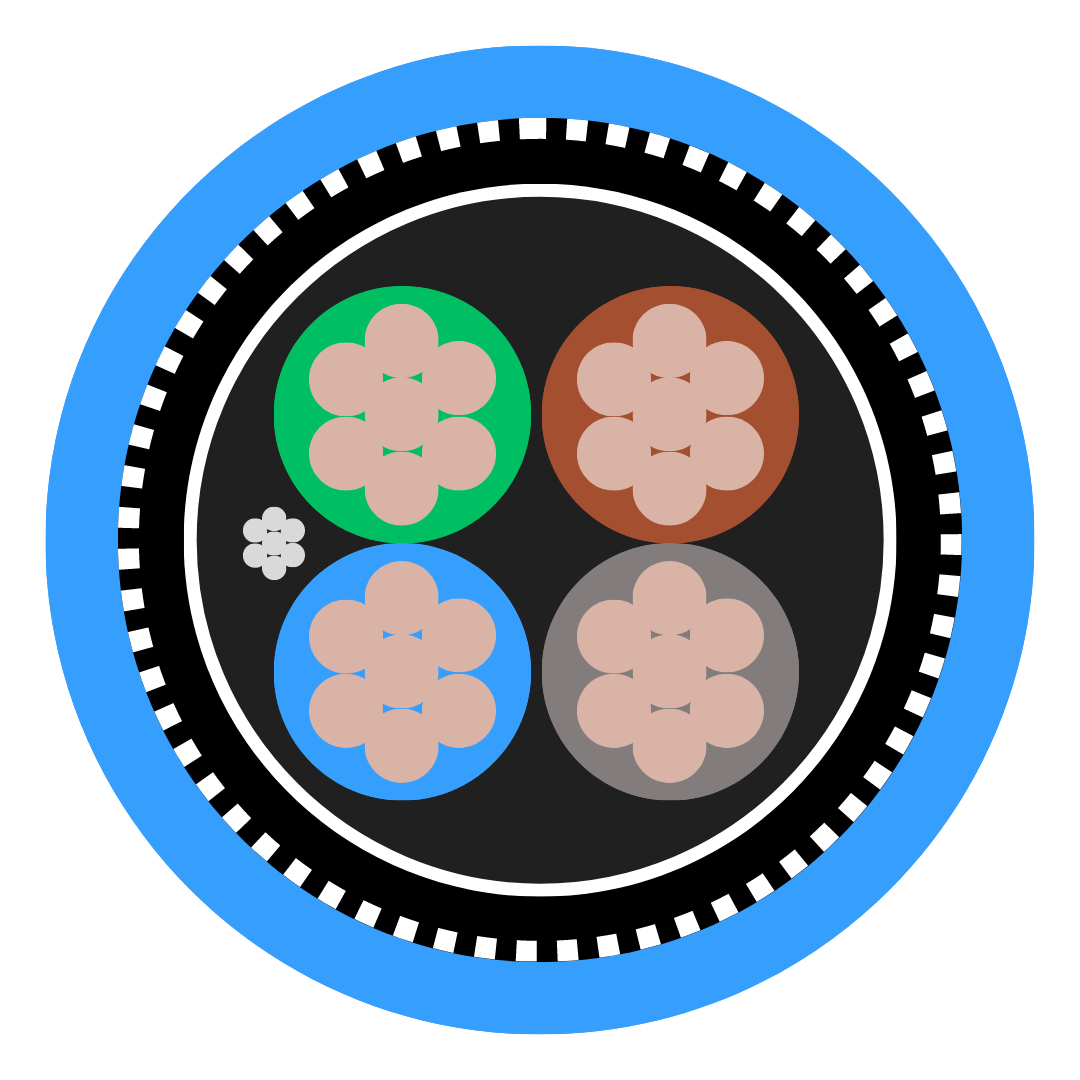Network cables are a key component that help to power our digital connections across the globe. Whether it’s for accessing the internet, managing data centres, or linking broadcasting studios, choosing the right cabling is essential.
In this article, we will be explaining the various types of network cables used in the communication industry, helping you understand which cables work best for different applications.
What are Network Cables?
A network cable is used to connect and transfer data between different network devices such as computers, routers, and switches. These cables are the physical channels through which internet and communication networks operate, allowing for data transmission over long and short distances.
They come in various types, each designed for specific networking requirements and environments, ensuring that users receive efficient and reliable data communication.
Network cables are important, not just in everyday internet access, but also in broader communication technologies, supporting everything from basic office networks to complex telecommunications infrastructure.
Types of Network Cables in the Communication Industry
Co-axial Cables
Co-axial cables, commonly referred to as coax, are widely used for transmitting high-frequency signals, such as cable television, telecommunications, internet connections, digital audio and surveillance systems.
These cables consist of a central conductor surrounded by an insulating layer, over which a metallic shield is placed to prevent electromagnetic interference. Due to their durability and effectiveness in blocking interference, co-axial cables are a reliable choice for broadband internet connections in homes and businesses.
Twisted Pair Cables
Twisted pair cables are the most common type of networking cables used in Ethernet networks. They consist of pairs of insulated copper wires twisted together, which helps to reduce crosstalk and electromagnetic interference.
There are two main types of twisted pair cables:
Unshielded Twisted Pair (UTP)
These are the most commonly used cables for office and home networks. UTP cables are cost-effective and work efficiently for small to medium-sized networks where interference is minimal.
Shielded Twisted Pair (STP)
These cables come with a foil or braided shield that covers the twisted wires. STP cables are ideal for environments with higher interference levels, such as industrial settings or areas with numerous electronic devices, as they provide better protection against electromagnetic interference.
These cables are used in a variety of network environments, from simple office setups to complex data centres, supporting different network speeds and bandwidth requirements.
Fibre Optic Cables
Fibre optic cables use glass or plastic fibres to transmit data as light signals. This allows for data transmission over longer distances and at higher bandwidths than metallic cables.
Fibre optic cables are becoming essential for fast connections in large network infrastructures like the internet, television, and across large areas like university campuses. The primary advantages of fibre optic cables include:
High-speed data transmission that is capable of supporting gigabit speeds and beyond.
Long-distance data transmission with less signal loss, making them ideal for connecting network segments that are geographically separated.
Immunity to electromagnetic interference which provides consistent and reliable data transmission.
Choosing the Right Type of Network Cable
When selecting network cables for your project or infrastructure, several key factors need to be considered to ensure efficient operation and cost-effectiveness:
Bandwidth Requirements
Assess the data transfer speeds necessary for your network. Higher bandwidth applications, like data centres or large commercial setups, may require advanced cable types like Cat6a or fibre optic cables.
Environmental Conditions
Consider the environmental factors such as temperature, humidity, and potential chemical exposures. For example, outdoor installations or industrial environments might need cables with protective insulation or weather-resistant properties.
Distance
Consider the length of cable needed for your network. Signal degradation can occur over long distances, especially with copper cables. Fibre optic cables are better suited for long-distance communication without loss of signal quality.
Ethernet Cable Categories and Specifications
Cat5e
This is a standard Ethernet cable that supports up to 1 gigabit per second at a frequency of 100 MHz. While Cat5e cables are suitable for most residential and some business applications, they are slowly becoming outdated as better performing cables are developed.
Cat6
The Cat6 is a more advanced option that supports speeds up to 10 Gbps at 250 MHz. With better insulation to reduce crosstalk, it's suitable for business environments where higher speeds are frequently required.
Cat6a
This extends the speed of Cat6 cables up to 10 Gbps but across a full 100 metres and at a frequency of 500 MHz. Cat6a cables are ideal for data centres and large enterprise networks.
Cat7
The Cat7 offers performance up to 10 Gbps at frequencies up to 600 MHz over 100 metres and has even more stringent crosstalk specifications. It's typically used in environments that require maximum speed and interference protection.
Network Cables at Cableworld
Whether you're working on a small residential project or across a significant area such as a university campus, Cableworld has the solution for you.
Network Cables FAQs
What are the different types of network cables used for internet connections?
For internet connections, the most commonly used types of network cables are co-axial cables, twisted pair cables and fibre optic cables. Co-axial are traditionally used for internet connections as they are reliable and can handle a considerable amount of bandwidth.
Twisted pair cables, including both Unshielded Twisted Pair (UTP) and Shielded Twisted Pair (STP), are standard for Ethernet and widely used in both residential and commercial environments. Cat5e and Cat6 are the most common in modern setups.
Fibre Optic Cables are known for their high speed and bandwidth capabilities, and are ideal for high-demand applications and long-distance communication without loss of signal quality.
Each type has its benefits depending on the requirements of the network, including speed, distance, and environmental factors.
How do I choose the right type of cable for my internet setup?
Choosing the right type of cable for your internet setup involves considering several factors including speed, distance and the environment.
Start out by determining the bandwidth needed for your internet usage. For high-speed internet, fibre optic cables are best, while Cat6 and Cat6a are suitable for moderate to high speeds.
Then measure the distance between network points. Fibre optics are preferred for long distances without compromising speed or quality.
Finally, consider the environment in which the cables will be installed. For areas prone to heavy electrical interference, shielded twisted pair cables (STP) are recommended.
Alarm Cable
Arctic Grade Cable
Armoured Cable
Audio & Speaker Cable
Auto Cable
Bare Copper
Belden Equivalent Cable
Co-axial Cable
Data Cable
DC Telecom Cable
Defence Standard Cable
Emergency Lighting & Fire Detection Cable
EV Cable
Festoon
![Loose Tube Fibre Cross Section]()
Fixed Wiring PVC & LSOH Cable
Flatform
Flexible Control Cable
Flexible PVC Cable
Flexible Rubber Cable
General Wiring Cable PVC & LSOH
High Temperature Cable
High Voltage Cable
![5308 p1 t2 cat Cross Section]()
LSOH Flexible Cable
Medium Voltage Cable
NYY & N2XH Cable
Protected Wiring Cable
Silicone Cable
Solar Cable
Split Concentric Cable
Spiral Cable
Temporary Power Cable
Tri-Rated Cable
Welding Cable
Alarm Cable
Arctic Grade Cable
Armoured Cable
Audio & Speaker Cable
Auto Cable
Bare Copper
Belden Equivalent Cable
Co-axial Cable
Data Cable
DC Telecom Cable
Defence Standard Cable
Emergency Lighting & Fire Detection Cable
EV Cable
Festoon
![Loose Tube Fibre Cross Section]()
Fixed Wiring PVC & LSOH Cable
Flatform
Flexible Control Cable
Flexible PVC Cable
Flexible Rubber Cable
General Wiring Cable PVC & LSOH
High Temperature Cable
High Voltage Cable
![5308 p1 t2 cat Cross Section]()
LSOH Flexible Cable
Medium Voltage Cable
NYY & N2XH Cable
PAS - BS5308 Instrumentation Cable
Protected Wiring Cable
RS-232 Cable
RS-485 Cable
Silicone Cable
Solar Cable
Split Concentric Cable
Spiral Cable
Telephone Cable
Temporary Power Cable
Traffic Signal Cables
Tri-Rated Cable
Welding Cable










































